Hate it or love it, AI (artificial intelligence) is absolutely everywhere you look in the music industry, whether you hate it or love it.
From laying down AI-generated melodies and fully structured songs to mixing, mastering, and sound design 一 it’s being taken advantage of left and right.
As producers, using AI can supercharge your music production process and completely transform your creative process.
It can help you generate music faster, cleaner, and more professionally.
That’s why I’m breaking down everything you need to know about music producers using AI and how you can too, like:
- Auto-generating melodies, chord progressions & basslines ✓
- Building full drum patterns in seconds ✓
- Smart EQ, compression tools, and other new technologies ✓
- AI-assisted mixing and mastering solutions ✓
- Vocal tuning, cloning & harmonies ✓
- Intelligent FX chains using AI systems ✓
- Music stem separation for easy sampling ✓
- AI-generated sounds & textures (cutting-edge) ✓
- How to integrate AI/machine learning tech like a boss ✓
- Using every technological advancement ✓
- Getting ahead in the music industry with AI music creation ✓
- Swerving ethical implications/copyright concerns ✓
- Much more about music producers using AI ✓
By learning all about music producers using AI in the industry with this blog post, you’ll be able to keep up with the latest AI music production tools and techniques.
Not only that, but successfully apply them to your own sessions (it’ll really open you up to a whole new landscape of creativity).
This way, your tracks will always sound fresh, stand out on streaming platforms, and feel more dynamic in every listeners’ environments.
Plus, you’ll never have to worry about creative block or repetitive production tasks ever again, which is a big plus if you ask me.
And, side note, I’m going to include an example for each section of famous music producers using AI in that same exact way.
Table of Contents
- How Music Producers Using AI Excel & Exceed (And How You Can Too)
- 1. AI-Generated Melody & Chord Progressions Using Chord Genie
- 2. AI-Generated Drums & Basslines Using Drum Monkey & Bass Dragon
- 3. Custom FX Chains Using Sound Doctor
- 4. AI Tools for Dynamic Beat Creation
- 5. Smart Mixing & Mastering
- 6. Vocal Tuning & Vocal Manipulation with AI
- 7. AI-Driven Audio Stem Separation for Sampling & Remixing
- 8. Creative Sound Design via AI-Based Synthesis Engines
- 9. AI-Powered EQ Targeting
- 10. Adaptive AI Compression
- 11. Smart Harmonic Saturation
- 12. AI Voice Cloning to Create Custom Vocal Identities
- 13. AI Groove Modeling to Humanize MIDI Timing & Velocity in Realistic Ways
- 14. Neural Networks: Everything You Need to Know
- Bonus: How Music Producers Using AI Are Eliminating Repetitive Tasks (And How You Can Too)
How Music Producers Using AI Excel & Exceed (And How You Can Too)
There’s a bunch of different ways you can start adding AI (artificial intelligence) into your sessions without losing any of the human feel. So, let’s break down exactly how music producers using AI are pulling it off. And, how you can use AI when you produce music as well. Trust me, it will make your creative process much easier, faster, and more efficient all day long.
1. AI-Generated Melody & Chord Progressions Using Chord Genie
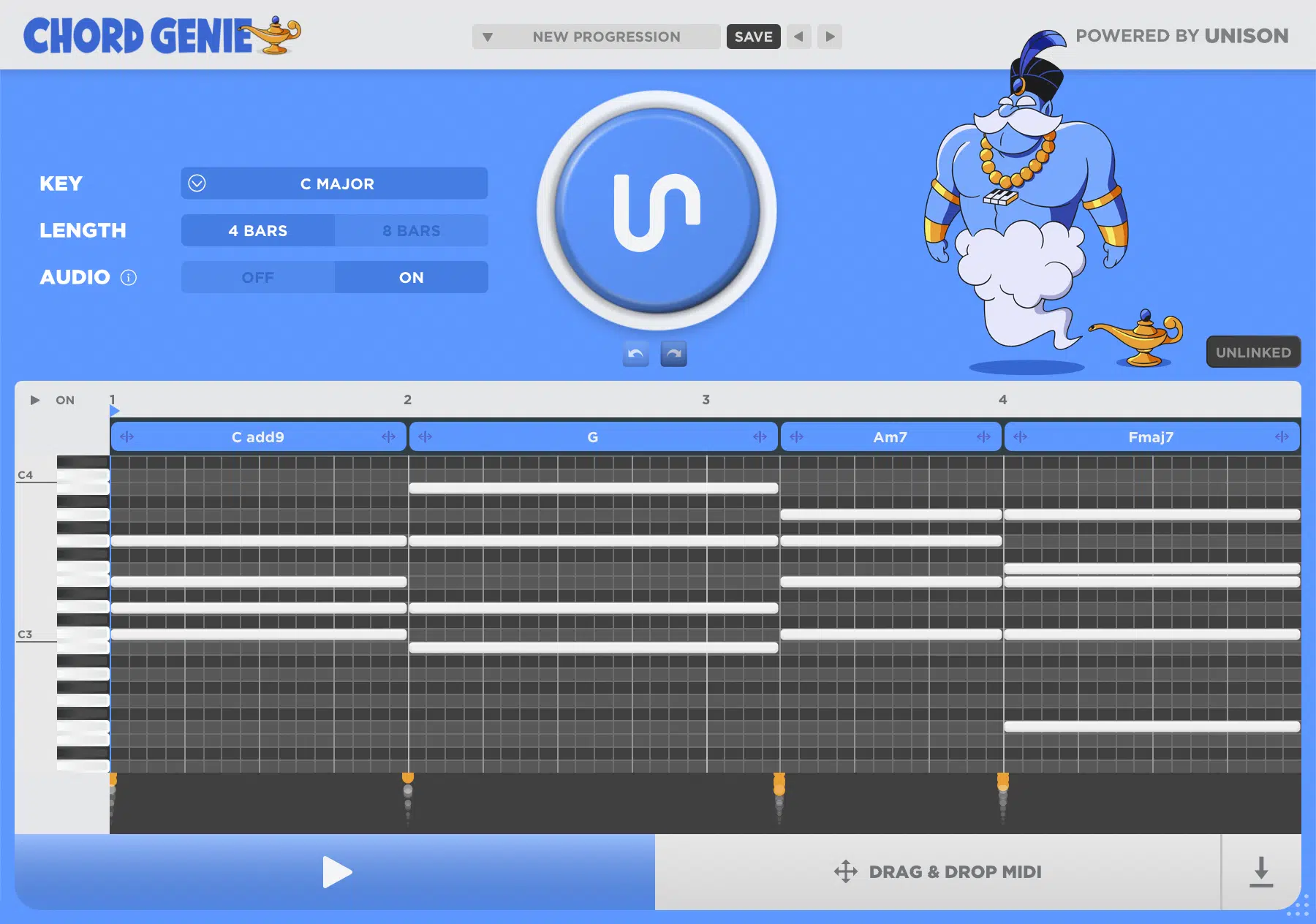
When it comes to knocking out melodies and chord progressions, Chord Genie is one of the most powerful AI music production tools available right now.
You can choose a vibe like emotional, dark, jazzy, or major uplifting, then instantly generate up to 12-bar progressions with built-in inversions and reharmonization options.
It offers over 1,200 professional chord progressions organized by genre and key, which makes it easy to stay creative without needing to know a thing about theory.
Each progression is fully editable in MIDI, which lets producers like yourself:
- Shift voicings
- Swap extensions
- Layer AI-generated melodies over the chords
And this is possible with just a few clicks.
This is exactly how music producers using AI are speeding up their music creation process by letting the AI handle the harmonic groundwork while still customizing the overall human feel of things.
So whether the goal is to create songs from scratch or just add new sounds to an existing track, Chord Genie helps unlock new creative possibilities fast.
Famous example: Mark Ronson has used AI-generated chord progressions to inspire new harmonic ideas, collaborating with platforms like Google’s Magenta to break creative blocks during songwriting sessions.
2. AI-Generated Drums & Basslines Using Drum Monkey & Bass Dragon
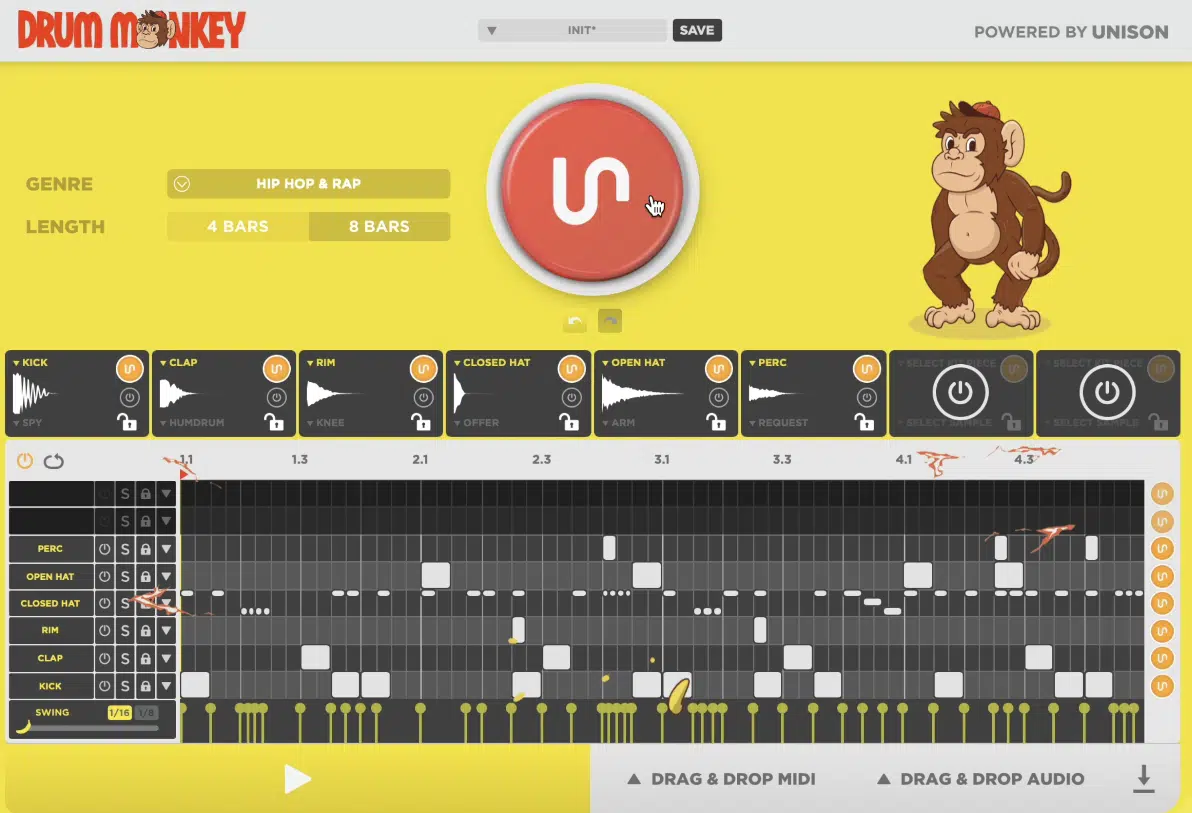
Drum Monkey and Bass Dragon are two legendary AI music production plugins that completely flip how producers lay down rhythm sections.
Drum Monkey can generate full 8-bar or 16-bar drum loops in all styles/genres like trap, EDM, house, drill, or boom bap, and includes over 4,000 genre-based patterns.
All of which are drag-and-drop ready in MIDI and audio formats.
Each pattern includes kick, snare, hi-hats, and percussion layers that can be randomized, locked, or humanized with swing and velocity settings between 1%–100%.
Then your have Bass Dragon, which syncs directly to the chord progression and genre of the track 一 building complex, editable basslines that react to:
- Key
- Scale
- Groove
- Rhythm
There’s actually over 250 unique bassline shapes, which is pretty impressive.
This is how music producers using AI are generating complete tracks within minutes…
Instead of wasting hours balancing low-end and percussion manually, these AI tools instantly lock everything into place for you.
From there, you can tweak these however you’d like.
Not only does it save time, but it also frees you up to focus on creating music that hits harder and sounds more polished right out of the gate.
Famous example: Metro Boomin has used AI-assisted tools to play around with unconventional trap rhythms. He’s got a lot of beat ideas for big-time artists like Future and 21 Savage this way.
Download Drum Monkey and Bass Dragon Now
3. Custom FX Chains Using Sound Doctor
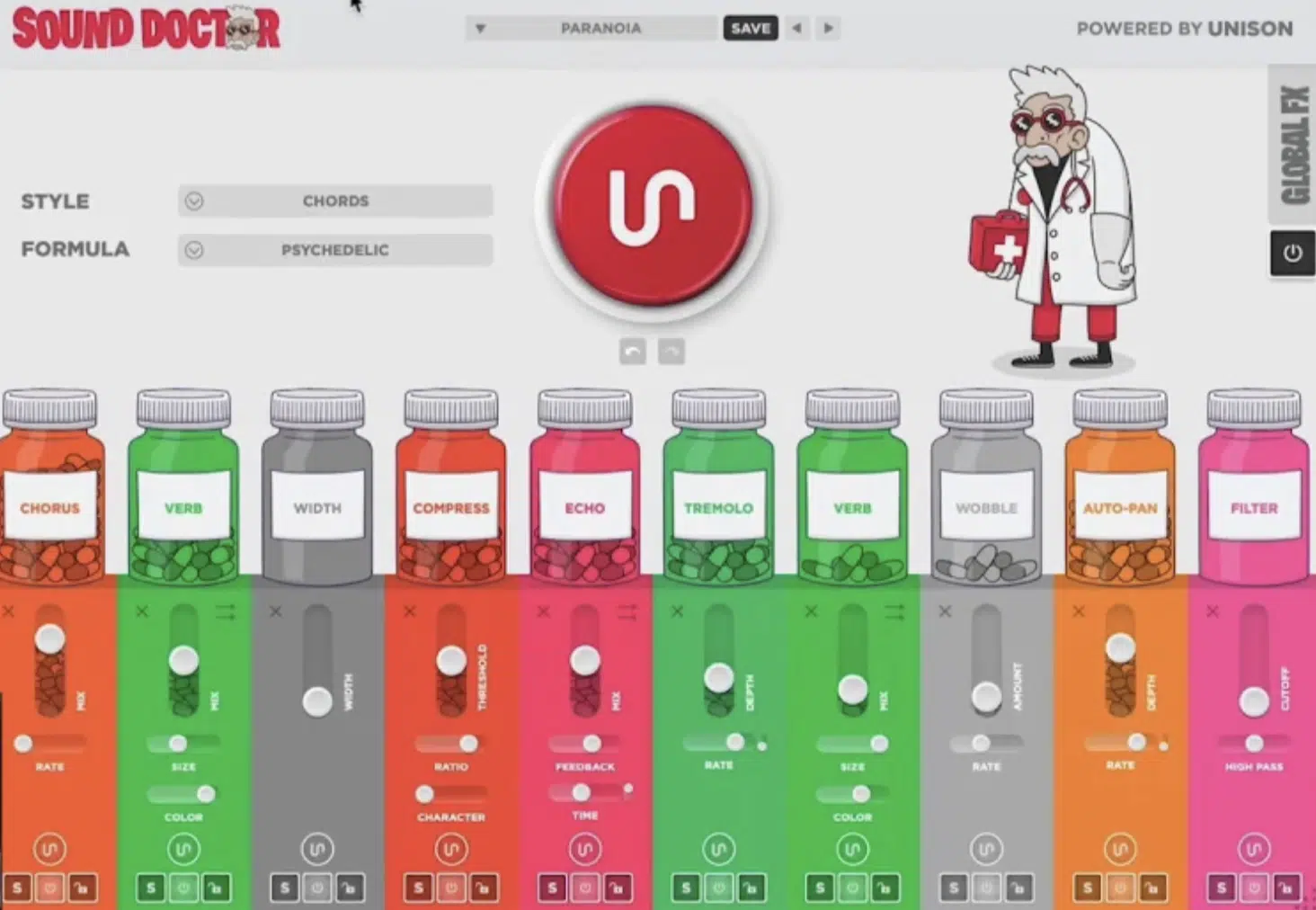
Sound Doctor is another epic AI-powered plugin that builds custom effect chains based on the content of the sound being processed.
It has saved countless producers from FX guessing all day.
With just one click, producers can generate intelligent chains of up to six effects, like:
- EQ
- Compression
- Saturation
- Reverb
- Transient shaping
- Stereo imaging
They’re all ordered and dialed in based on the input audio.
You can see the settings, which are displayed in real-time, show you exact EQ curves, compression thresholds, ratio settings (typically between 2:1 and 4:1), and wet/dry mix amounts for time-based effects.
You can lock or remove individual effects and regenerate just the ones you want 一 letting you tweak the chain while keeping the AI’s smart decisions in play.
This is how music producers using AI are creating cleaner, more dynamic mixes faster, by turning one static sound into something complex, polished, and mix-ready.
And the best part is, there’s no manual routing required.
Whether it’s drum buss processing, vocal chains, or synth widening, Sound Doctor handles the heavy lifting while still giving full control over the final result.
Famous example: Finneas has taken advantage of AI-driven plugins to automate complex FX chains, fast-tracking the process of shaping Billie Eilish’s vocal textures while maintaining consistency in their mixing workflow.
4. AI Tools for Dynamic Beat Creation
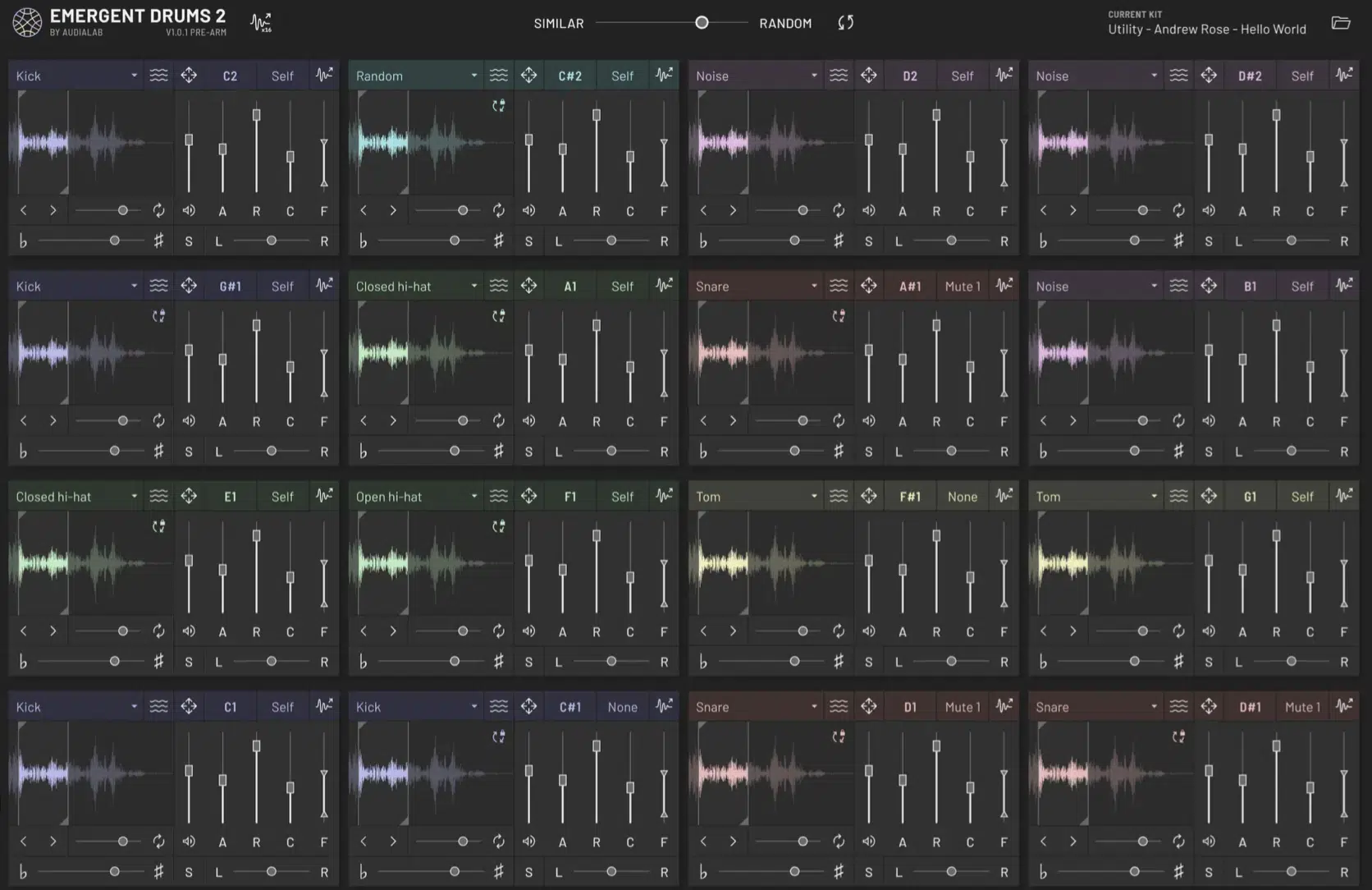
If you’re trying to lay down drum patterns fast without them sounding stale or robotic, AI tools for beat creation can take things to the next level.
With plugins like Emergent Drums 2 by Audialab, you can generate brand-new drum samples using neural networks trained on thousands of high-quality kits.
Meaning, every sound is unique and tailor-made to your specific session.
From there, AI in music plugins like Beat Scholar let you sequence patterns in up to 44 subdivisions per bar.
This gives you way more groove control than traditional step sequencers ever could.
You can do super cool things like,
- Randomize velocity between 50–110%
- Apply swing across just the hats or snares
- Regenerate only certain parts of the beat while locking in your favorite elements
That’s how music producers using AI are keeping their beats fresh and dynamic…
By using smart AI tools that react to your track’s rhythm and helping you build patterns that hit hard but still feel human, you can take advantage of it as well.
Famous example: Grimes has used AI tools into her production process to generate dynamic beats, which lets her explore new rhythmic patterns and textures that complement her hybrid/experimental sound.
5. Smart Mixing & Mastering
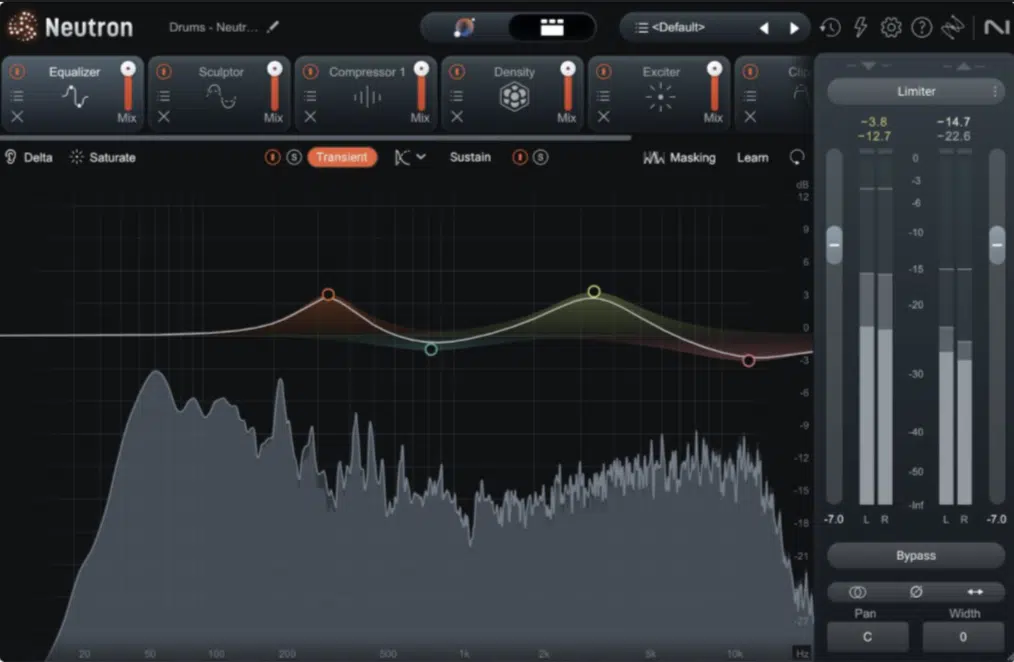
Mixing and mastering with artificial intelligence isn’t just a trend.
It’s a full-on gamechanger for anyone trying to get clean, consistent results without wasting hours second-guessing settings.
With plugins like iZotope Neutron 5 and Ozone 11, you can analyze your track and right away get smart:
- EQ suggestions
- Compression settings
- Stereo imaging tweaks
- Limiter thresholds
And yes, they’re all tweakable to your specific genre and loudness goals.
Let’s say you want to target -14 LUFS for streaming platforms…
Ozone will set your threshold and ceiling automatically, usually around -0.8dB true peak, and back it with multiband limiting that still leaves your transients intact.
Neutron will recommend EQ cuts (like -3dB around 200 Hz for muddy vocals), a 3:1 compressor with a 10ms attack, and stereo width expansion on your mid-highs, so your track sounds big without losing focus.
That’s why music producers using AI are finishing mixes faster; way faster, honestly.
Once you dial in the basics with these AI music production tools, you’re free to get creative with FX, automation, and final tweaks that bring the song to life.
Famous example: Deadmau5 has incorporated AI in music when it comes to mastering services to achieve polished final mixes, taking advantage of AI technology to fine-tune his tracks with razor-sharp precision.
Side note, if you want to learn everything there is to know about AI mixing or AI mastering, I got you covered.
6. Vocal Tuning & Vocal Manipulation with AI
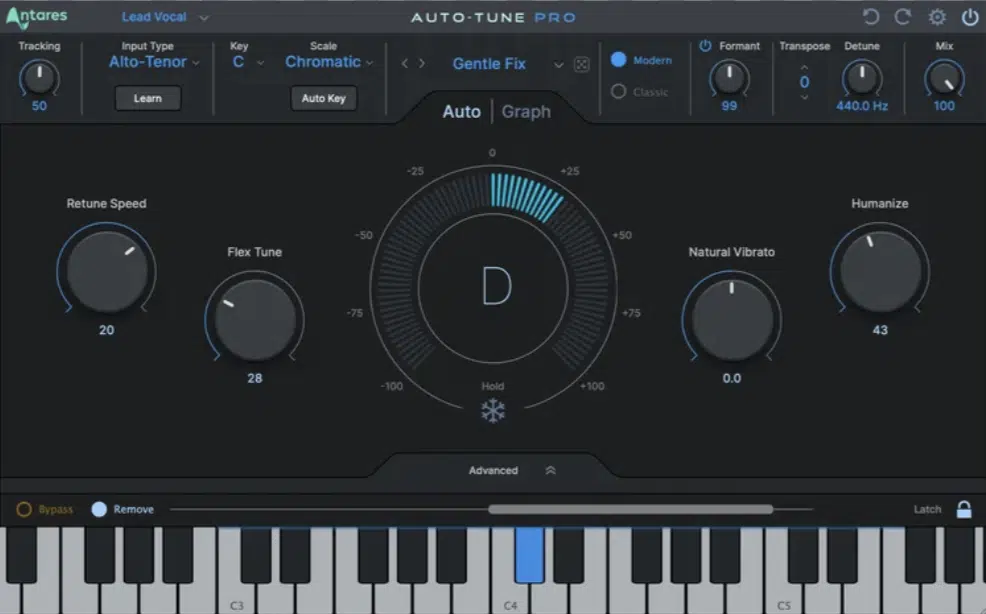
Getting clean vocals that still sound natural used to take hours, but now, thanks to AI vocal tuning and manipulation tools, you can get pro results in just a few takes.
You can take advantage of plugins like Auto-Tune Artist or Waves Tune Real-Time to lock vocals into key with settings like 10–20 ms retune speed for transparent correction.
Or, crank it tighter for that modern, robotic tone used in pop and trap.
You can even tell the plugin to allow vibrato between 50–60% and focus pitch correction only on certain ranges, like C4–G5, so the natural phrasing stays intact while hitting every note (pretty cool, right?).
On top of that, tools like Voicify and Lalals let you switch:
- Vocal tone
- Gender
- Even language
All without having to record a new take, which is perfect for creating multiple versions or experimenting with AI-generated vocals.
That’s how music producers using AI are dialing in vocals that sit perfectly in the mix 一 clean, tuned, expressive, and ready to go without endless takes or over-editing.
Famous example: Imogen Heap has been a pioneer in using AI for vocal processing, using tools that allow for intricate tuning and manipulation to create unique vocal soundscapes that really blow people’s minds.
Side note, if you want to learn everything about AI singing generators, I got you.
7. AI-Driven Audio Stem Separation for Sampling & Remixing
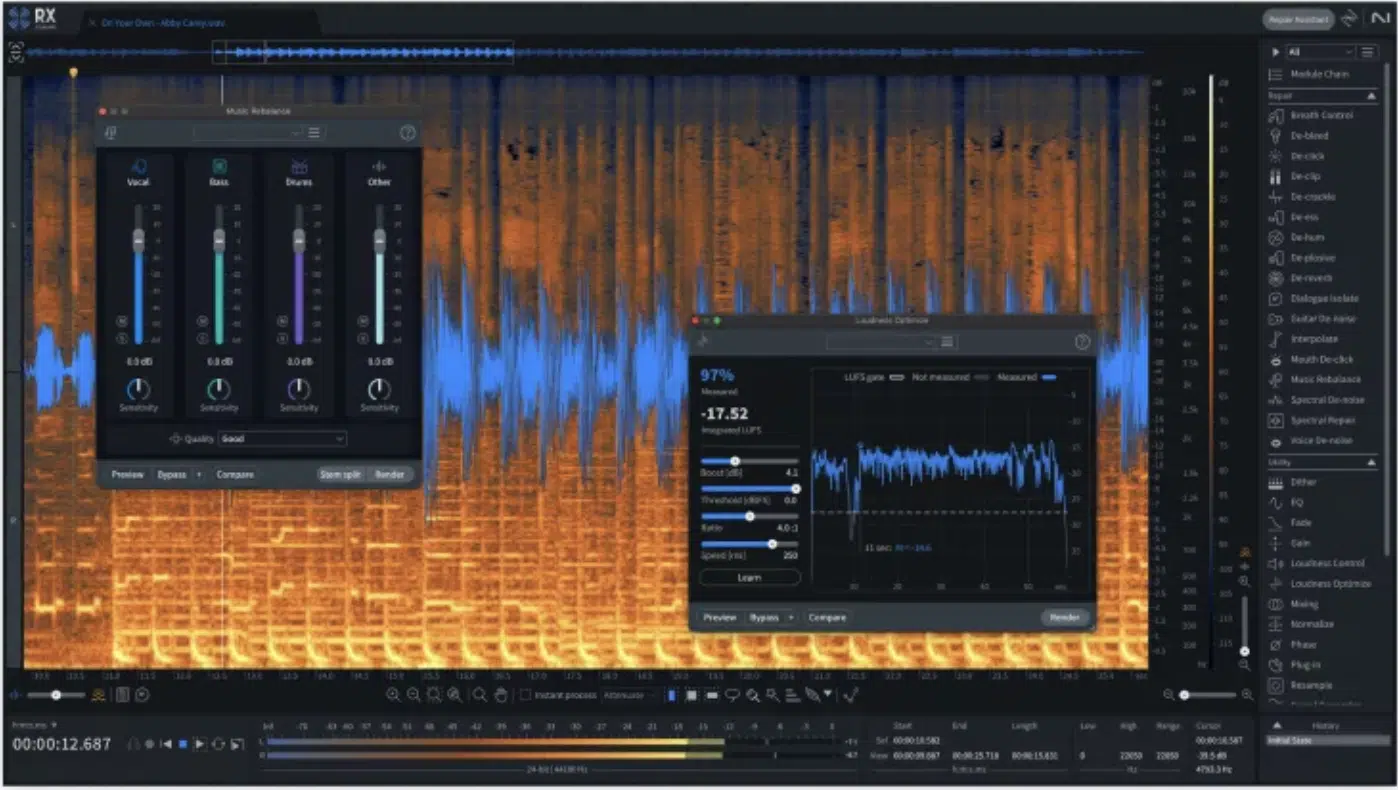
If you’re working with existing music and want to flip it into something brand new, stem separation using AI in music is one of the most powerful techniques out there.
Tools like Lalal.ai, Spleeter, and RX 11 Music Rebalance can isolate vocals, drums, bass, and other instruments with just a couple of clicks.
Often with accuracy above 95% for clean, studio-grade stems, just saying.
You can pull an acapella from a full mix, drop it into your session, then layer new AI-generated sounds or melodies underneath without ever touching the original instrumental.
And for remixing purposes, you can solo just the drums or bass, tweak them using EQ and saturation, and build around the groove.
This is something music producers using AI are doing more and more to create tracks that feel brand new but still reference the source.
This kind of stem separation gives you full freedom to sample creatively, remix existing songs, or even generate music beds for live shows and DJ edits.
You never have to worry about spending hours manually isolating parts again (something we never thought possible 10 years ago).
Famous example: When it comes to incorporating AI, Boi-1da is definitely on the list because he collaborated with AudioShake’s AI technology to remix tracks for his AI-powered EP, “The Concept A.I.bum.” This demonstrates the creative potential of stem separation in modern production.
8. Creative Sound Design via AI-Based Synthesis Engines
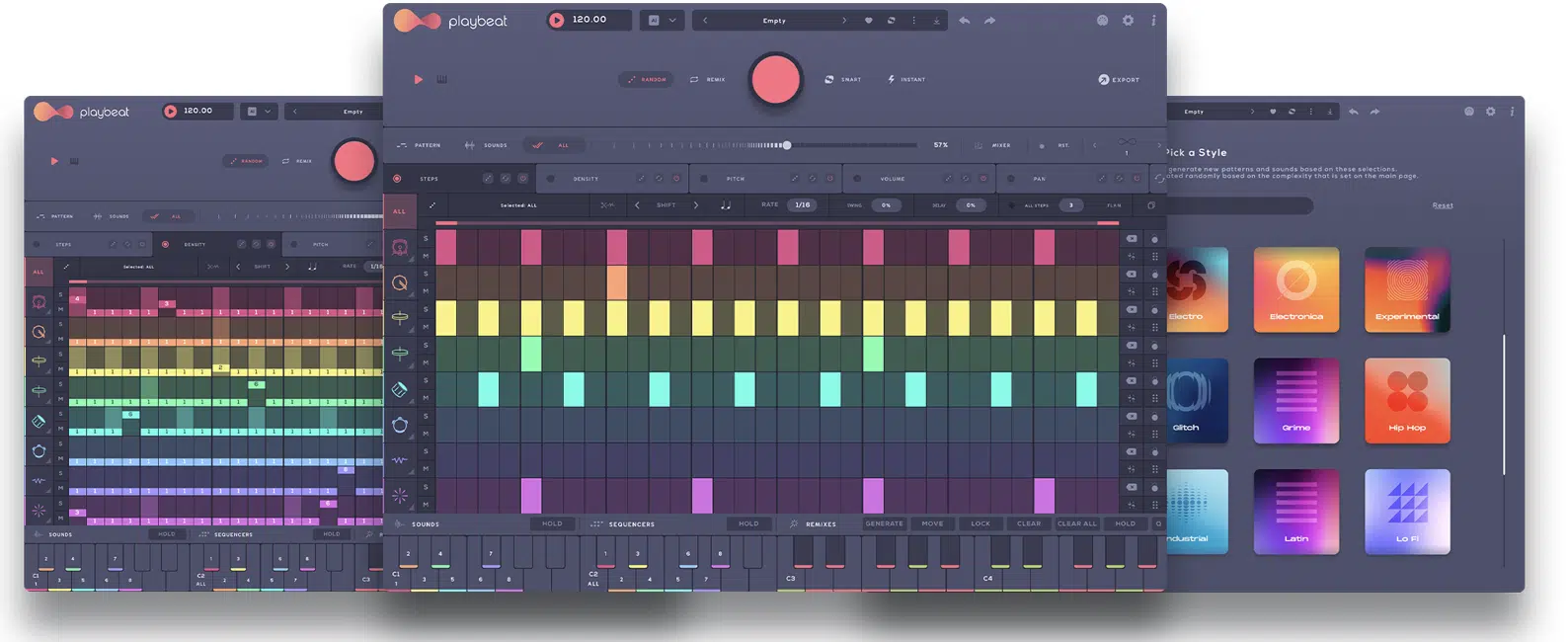
For producers who love designing new sounds from scratch like myself, AI-based synthesis engines are opening doors that regular synths just… can’t.
With tools like Emergent Drums 2, Google’s NSynth, or Playbeat 3, you can generate sounds from neural networks trained on thousands of samples.
This way, you can knock out textures you’d never get from standard oscillators or samplers the old-school way.
For example, you can easily:
- Dial in pitch ranges (say, C1–C3 for kicks or snares)
- Tweak decay curves
- Adjust harmonic density for each hit
And because the sounds are AI-generated, they’re not just rehashed presets, they’re totally fresh and exciting, which is also great.
These AI tools also allow you to input your own audio and mutate it using machine learning 一 giving you control over tone, shape, transients, and randomness levels between 0–100%.
That’s why music producers using AI (artificial intelligence) synthesis tools all over the world are always pushing their sound forward.
When you’re building from AI-generated sounds, you’re not simply chasing trends, you’re setting them.
Remember, when it comes to AI in music/using music AI tools, it’s not to take over, it’s about enhancing your own unique style.
Famous example: Brian Eno has experimented with AI-based synthesis engines to bang out evolving soundscapes, pushing the boundaries of ambient music through generative processes.
9. AI-Powered EQ Targeting
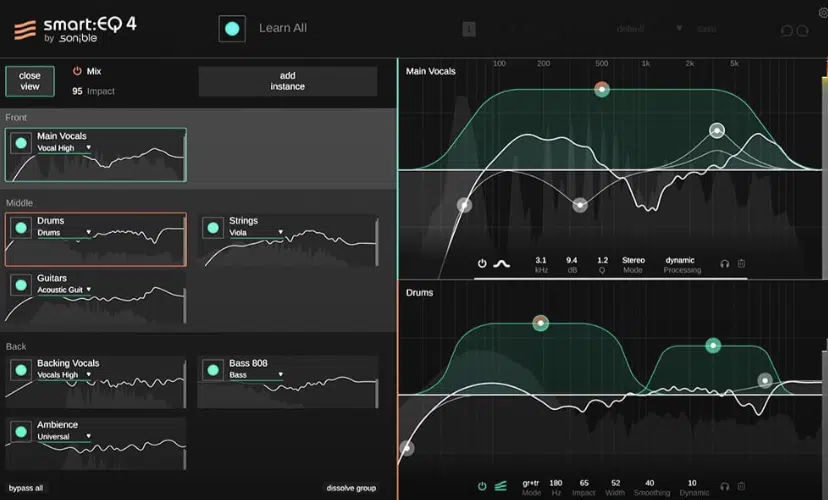
Getting your mix to sound clean without over-EQing can be tough sometimes, especially if you’re aiming for perfection, which I’m sure you are.
Luckily, AI-powered EQ targeting solves that by analyzing your tracks and recommending precise frequency moves.
With smart EQs like Gullfoss, smart:EQ 4 by Sonible, or Neutron 5, you can see clashing frequencies in real time and apply surgical cuts or boosts with just a click.
For example, smart:EQ 4 might automatically pull out -2.5dB around 320 Hz on a muddy vocal or boost 6kHz by +1.8dB to bring out clarity.
And, you can even set analysis to focus on vocal, drum, or synth profiles depending on the source.
Each plugin also lets you control the strength of the AI processing with intensity sliders (usually 0–100%) so you can dial in subtle shifts or aggressive tonal changes.
It all depends on your overall mix goals and what genre/style you’re working with.
This is exactly how music producers using AI tools are getting more balanced mixes faster; by letting intelligent EQs handle the technical side while they focus on the creative process.
Famous example: Young Guru has used AI-powered EQ tools to achieve precise frequency balancing in his mixes like it’s an art, enhancing clarity and depth in tracks for artists like Jay-Z.
10. Adaptive AI Compression
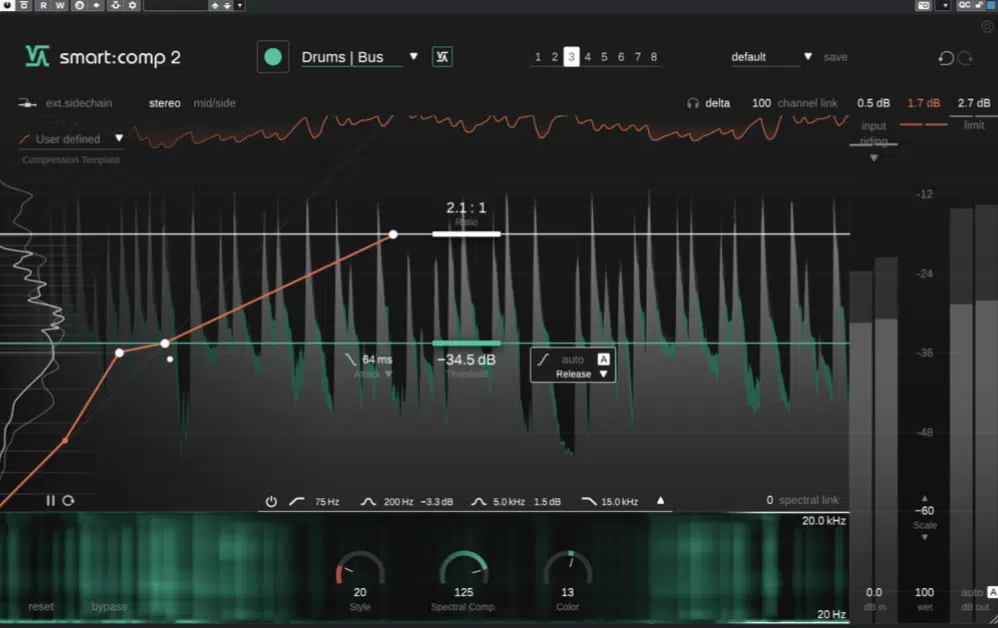
Compression can either glue your mix or completely ruin your transients, which is why using adaptive AI compression can be so beneficial.
Music AI tools like Sonible smart:comp 2 analyze your audio in real time and recommend threshold, ratio, attack, and release based on:
- The material
- Loudness targets
For example, smart:comp might suggest a 3:1 ratio with a -18dB threshold, 15ms attack, and 80ms release on a lead vocal, while adjusting dynamically as the energy of the track changes (whatever will work best, you’ll see right away).
You can also use spectral compression modes on the music created to compress only certain frequency bands 一 like taming low-end rumble without flattening your mids.
And, tweak the adaptation curve so the plugin follows your track’s rhythm.
That’s why music producers using AI are getting tighter, punchier mixes with less trial and error, because these adaptive tools react to the sound, not just the settings.
Famous example: Tony Maserati has adopted adaptive AI compression techniques to maintain dynamic range while ensuring consistency across various playback systems in his mixing projects.
11. Smart Harmonic Saturation
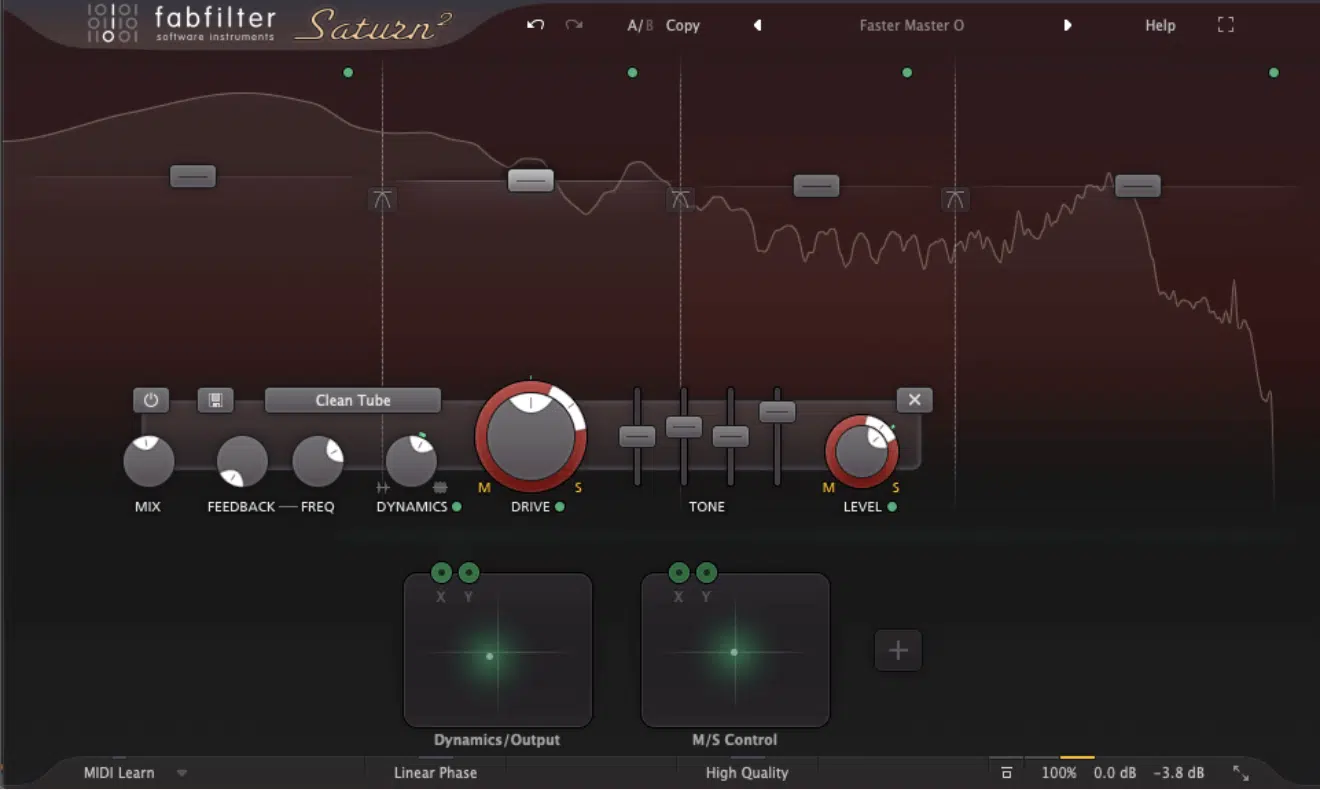
If your mix sounds too clean or lifeless, smart harmonic saturation can help you add depth and character without muddying everything up.
Plugins like Saturn 2 or Soundtoys Decapitator use artificial intelligence/new technologies to apply saturation only to frequency zones that actually benefit from it.
This could be like enhancing mids around 800 Hz or adding subtle brightness above 10kHz, and the like.
You can dial in soft tube warmth on vocals, tape-style crunch on drums, or push a transient-heavy synth through a modeled transformer circuit to get a more analog feel.
Some AI music production tools even let you match saturation profiles from existing music, which means you can recreate the same harmonic balance found in industry-level mixes (pretty cool, right?).
That’s how music producers using AI and smart saturation plugins are bringing back that human touch and creative tone without overdoing it or killing headroom.
Famous example: Andrew Scheps has explored AI-driven saturation plugins to add harmonic richness to his mixes, emulating analog warmth in a digital environment.
12. AI Voice Cloning to Create Custom Vocal Identities
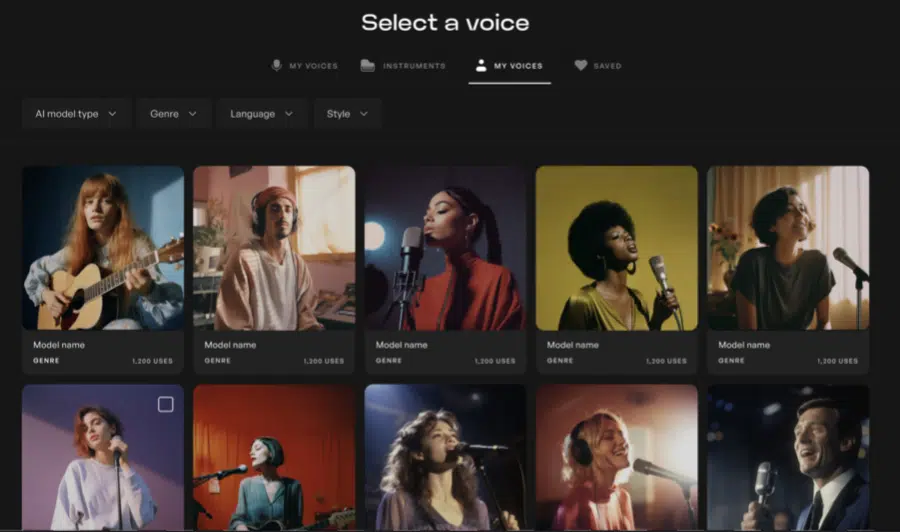
AI voice cloning is giving music producers using AI the power to create entirely new vocal styles without needing a new session vocalist.
With tools like Voicify, Amper Music, and Kits.AI, you can upload a dry take and generate music with a completely different tone, gender, or even language.
You can adjust pitch, vibrato, and breathiness using sliders that range from 0 to 100 一 making it easy to dial in a specific vibe for each track.
This is great for when you’re:
- Creating music for different audiences
- Syncing vocals to multiple versions
- Testing out ideas before committing to a final take
Plus, the possibilities for building an artificial intelligence virtual artist that sounds totally original are now wide open.
Just one more way AI tools are helping producers evolve in this new era of music.
Famous example: Holly Herndon developed an AI vocal clone named “Spawn” to explore new vocal textures and challenge traditional notions of identity in music after the composition begins.
13. AI Groove Modeling to Humanize MIDI Timing & Velocity in Realistic Ways
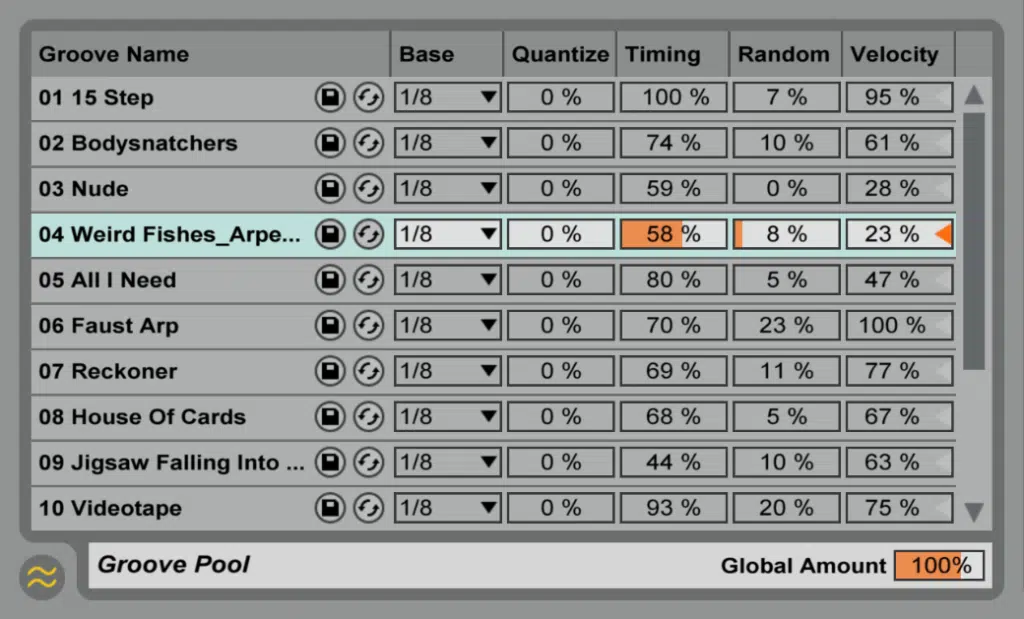
Dragging and dropping drums is cool and all, until everything starts sounding stiff, which is where AI groove modeling steps in to make your MIDI feel alive.
With tools like Ableton’s Groove Pool or even Logic’s Smart Quantize, you can adjust swing, timing, and velocity randomness on a micro level.
Even down to ±3ms delays or velocity shifts of 10–20%.
They study how human drummers actually play, then apply those same slight imperfections to your patterns so everything feels more real and less robotic.
You can even load grooves from existing music you like and apply the same swing or pulse to your own MIDI, giving your beats that same bounce without copying melodies.
That’s why music producers using AI groove modeling are able to generate music that hits harder and feels way more natural in every listeners’ environments.
Famous example: Flying Lotus has used AI groove modeling to humanize MIDI sequences 一 adding subtle timing variations that bring a more organic feel to his electronic compositions.
14. Neural Networks: Everything You Need to Know
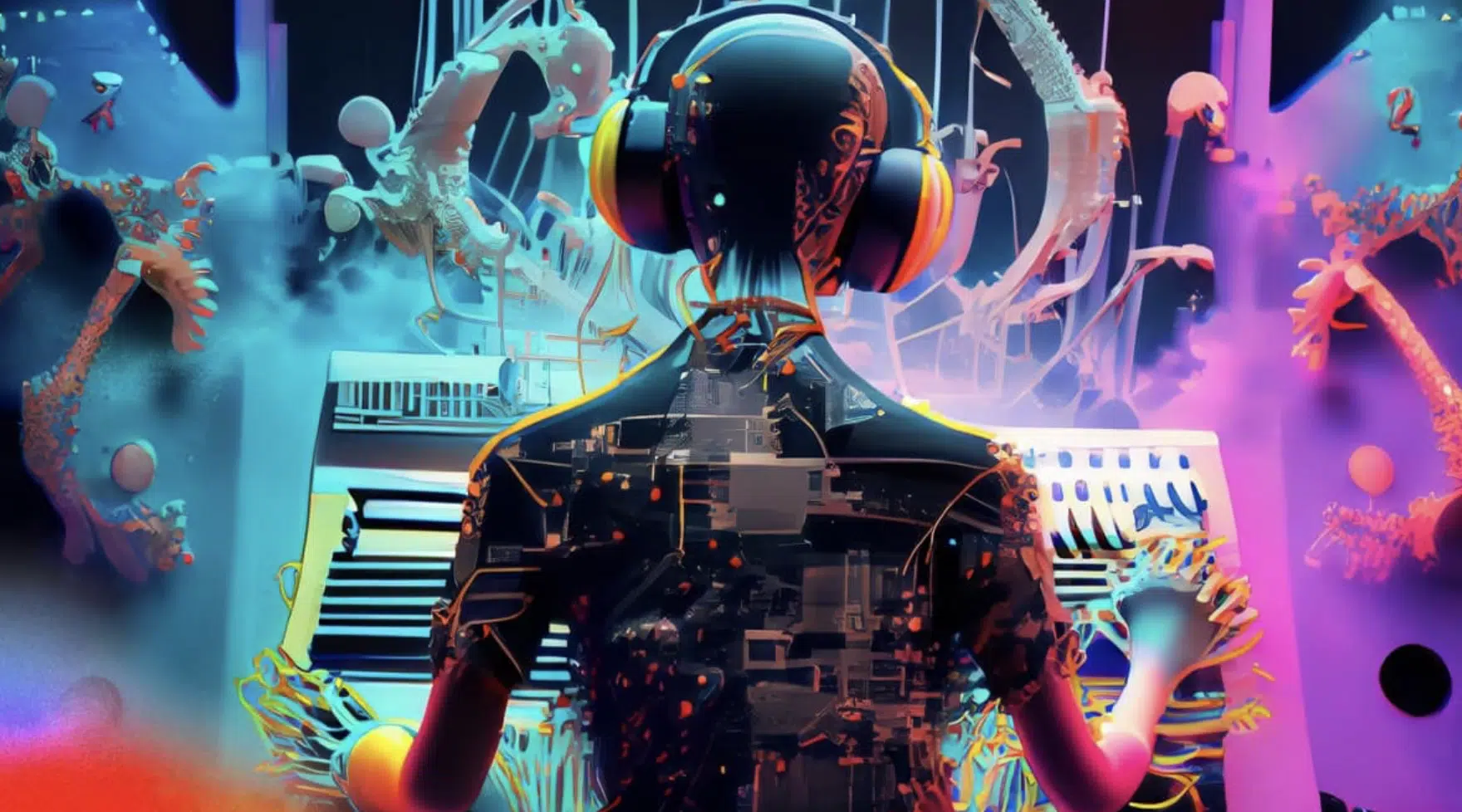
Neural networks are the backbone of a lot of AI-generated music, and understanding how they work gives you a serious edge as a producer.
They use deep learning to process thousands of hours of music (everything from chord changes and melodies to rhythmic flow) and then generate music patterns based on that data.
Plugins powered by neural networks can predict what note, chord, or beat comes next based on context.
It’s what makes them so good at helping you create complete tracks from scratch.
Some AI tools even allow you to feed in your own songs or stems…
This way the AI can learn your style and assist with future music production projects or interactive music experiences.
That’s why music producers using AI that’s built on neural networks are producing faster, with more creativity, and getting closer to real-time co-creation than ever before.
Famous example: BT has utilized neural networks in his compositions, creating generative AI music pieces that evolve over time for some seriously interesting tracks.
Remember, it’s all about blending human composers/producers skills and artificial intelligence for the perfect combination (think of it like a creative partner).
Bonus: How Music Producers Using AI Are Eliminating Repetitive Tasks (And How You Can Too)

There’s a lot of boring stuff that eats up your time when you produce music, like naming files, tagging sounds, or organizing stems.
Well, that’s exactly where AI tools come in handy, even if you don’t really believe it in as a whole quite yet.
With smart tagging systems, your files can be auto-named by key, BPM, and mood using metadata extraction.
While stem generators like Lalal.ai sort vocal, bass, and drum parts in seconds like we talked about a little while ago.
Some AI music production tools even auto-suggest plugin chains based on your track’s genre and loudness.
It helps you completely skip the setup phase and jump straight into the creativity.
You can also batch process vocals, generate harmonies, or even master entire playlists with AI-generated mastering options that adapt to different streaming platforms.
When you look at how musicians/music producers using AI are working now, it’s clear that they’re spending way less time on the repetitive stuff and way more time doing what actually matters: making music that will blow people’s minds.
So, whether you’re on board with artificial intelligence in the production world or not, there are definitely perks.
It can help you finish songs faster, stay organized, and stay focused on your best ideas without getting sidetracked.
Just remember that AI isn’t here to replace your creativity 一 it’s here to boost it, so you can make music that actually sounds like you, just way more on point.
Until next time…






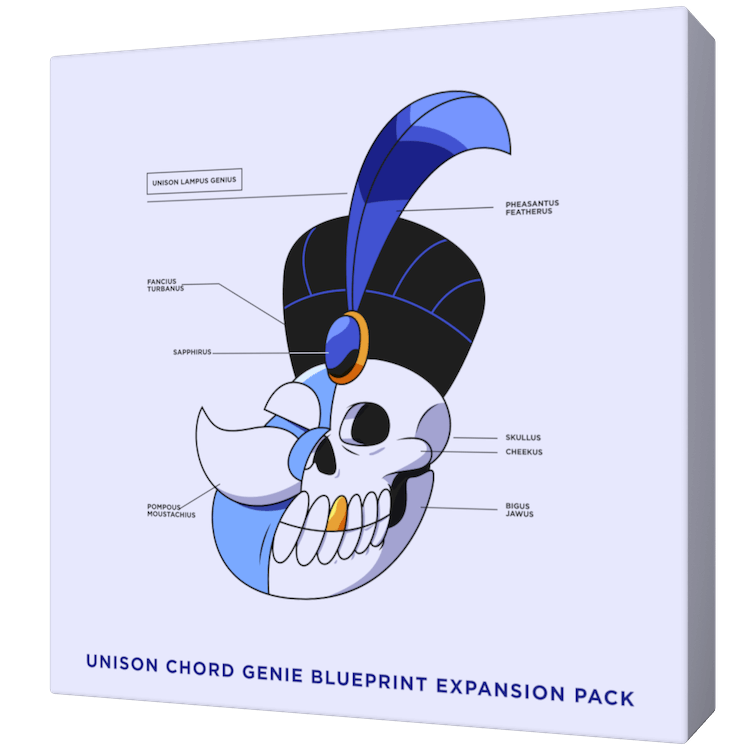
Leave a Reply
You must belogged in to post a comment.